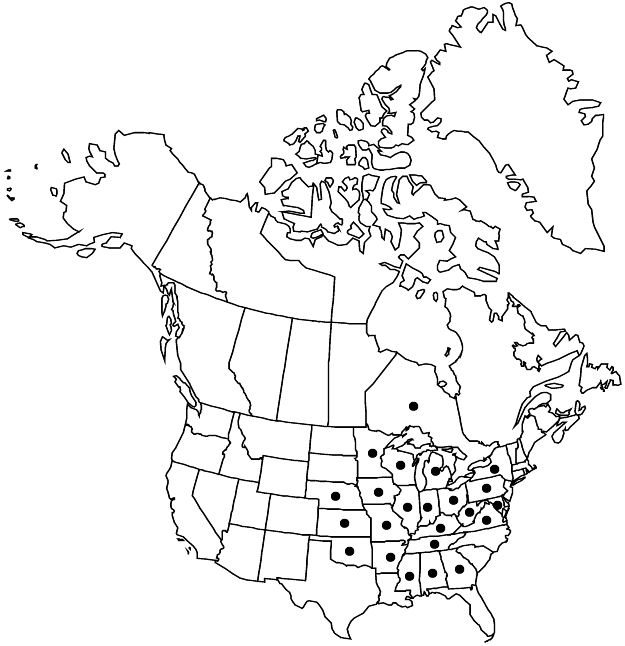Crataegus calpodendron
Gesch. Bot., 83. 1793.
Shrubs or trees, usually multistemmed, 50–70 dm. Stems: twigs: new growth golden brown, appressed-pubescent, 1-year old brown to grayish brown, 2-years old gray-brown, older ± pale gray; thorns on twigs absent or numerous, recurved (if longer), 1-year old shiny, dark-brown, older turning gray, slender, 2.5–6 cm. Leaves: petiole length 25–30% blade, narrowly winged most of length, finely pubescent, eglandular; blade ± rhombic or rhombic-narrowly ovate, sometimes suborbiculate, 3–12 cm, thin, base cuneate, lobes 0 or 5–8 per side, sinuses shallow, lobe apex subacute to acute, margins serrate except in proximal 1/4, veins 8 per side, apex usually acute, abaxial surface persistently appressed-pubescent, especially on veins, adaxial scabrate young, glabrous mature. Inflorescences 12–25-flowered; branches densely appressed-pubescent; bracteoles linear, margins stipitate-glandular. Flowers 13–15 (–22) mm diam.; hypanthium pubescent; sepals narrowly triangular, length not recorded, margins nearly entire or shallowly glandular-serrate, abaxially pubescent, adaxial pubescence not recorded; stamens 20, anthers usually red, pink, or purple, sometimes white, small; styles 2 or 3. Pomes orange-red to scarlet, ellipsoid to sometimes orbicular, (5–) 7–9 (–10) mm diam., pubescent; flesh soft; sepals reflexed or spreading; pyrenes 2 or 3, sides pitted. 2n = 34, 51.
Phenology: Flowering May–Jun; fruiting Sep–Oct.
Habitat: Open woods, brush, field margins
Elevation: 10–800 m
Distribution

Ont., Ala., Ark., Ga., Ill., Ind., Iowa, Kans., Ky., Md., Mich., Minn., Miss., Mo., Nebr., N.Y., Ohio, Okla., Pa., Tenn., Va., W.Va., Wis.
Discussion
Crataegus calpodendron is most common in the northern and Appalachian part of its range, where it is more likely to grow in the open (shrubs to 50 dm); in the southern part of its range, it is often in shaded habitats (trees to 70 dm). The distinctive vase-shaped branching pattern of well-grown northern C. calpodendron makes it easily distinguished even in winter, the lack of a central dominant trunk and the arching side trunks being characteristic. In open areas in the northern part of its range, mature leaves of C. calpodendron are often somewhat coriaceous and keeled along the midvein. In the south, the leaves remain thin until maturity. It is the second latest native hawthorn to flower, usually mid June (north) and early May (south, for example, central Alabama).
Vegetatively, distinction between Crataegus calpodendron and C. succulenta or C. macracantha is best supported by the more strongly impressed leaf venation, usually glabrous abaxial leaf surfaces, dark purple-brown, shiny, one-year twigs, and often longer and stouter thorns in the latter.
Crataegus calpodendron is variable in branching pattern, indumentum, and leaf and fruit shapes. Examination of a large number of specimens does not reveal discontinuities between leaf shapes, neither do these shapes correlate with the varieties hitherto recognized primarily on fruit characteristics. In general, C. calpodendron in the narrow sense, C. globosa, C. mollicula, and C. mollita represent forms with narrower, rhombic-elliptic, less deeply incised leaves with somewhat blunter lobes and teeth; C. hispidula, C. insperata, and C. obscura represent forms with nearly isodiametric leaves, the deepest and sharpest sinuses, and the biggest and sharpest teeth; C. scabera and C. spinulosa are intermediate. Smaller leaf and pome sizes are more common in drier or hotter terrain.
Crataegus ×rupicola Sargent (synonym of C. harveyana Sargent), from Missouri, represents a form with glands at the base of the leaf and on the petiole and perhaps is not pure calpodendron. Crataegus warneri Sargent from east-central Texas is provisionally placed here, although it could be a hybrid or hybrid derivative of C. calpodendron × C. crus-galli or an odd form of C. ashei with ten stamens and red anthers. Crataegus warneri has broadly ovate leaves 3.5–5 cm and appears to be somewhat xeromorphic; it is distinguishable from other forms of C. calpodendron with similar leaves only by its ten stamens and lack of pitted pyrenes. Crataegus ×simulata Sargent, from Missouri, is a probable hybrid of C. calpodendron with C. reverchonii var. palmeri (as C. palmeri) according to E. J. Palmer (1952). Crataegus ×vailiae is the most convincing hybrid of C. calpodendron (with C. uniflora; see Interserial Hybrids).
Selected References
None.
Lower Taxa
"thin" is not a number."glandular-serrate" is not a number. "entire" is not a number."winged" is not a number."adnate" is not a number."dm" is not declared as a valid unit of measurement for this property.